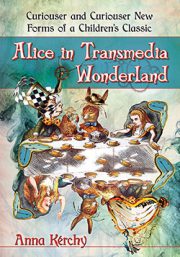There are many, many texts, societies, journals and studies that deal with nothing but Lewis Carroll‘s Alice stories. This one, however, researches how the original story (or its texts) has transformed into many other forms of media, virtually designing various forms of a “Transmedia Wonderland.”
 Anna Kérchy follows adaptations of the tales “across a variety of popular media platforms, ranging from novel, cinema, photo, music, comics, pop-up paper craft to iPod application, fanfiction, themepark ride, puppetry, ballet and body-art performance.”
Anna Kérchy follows adaptations of the tales “across a variety of popular media platforms, ranging from novel, cinema, photo, music, comics, pop-up paper craft to iPod application, fanfiction, themepark ride, puppetry, ballet and body-art performance.”
Lewis Carroll published Alice’s Adventures in Wonderland in 1865 and Through the Looking-Glass, and What Alice Found There in 1871. The little girl’s story easily is adaptable to various kinds of presentations, in whatever strange mode; taking for granted the unusual original story and its sequel. The many adaptations throughout the decades have proved that creative “reinterpretations record and resolve their own era’s specific cultural anxieties, struggles, desires and dreams, while amply proving the versatility and mutability of Alice’s story across time, space and discourse.” The two stories inspired almost 200 literary imitations and parodies between 1869 and 1930 alone.
The nature of the original texts, filled with allusions, riddles, rebellious attitudes, grammatical hoaxes, literary nonsense and surrealist interpretations of reality, however, make new interpretations (or rather improvisations) rather easy. Grouping several approaches in sections, chapter one then deals with visual nonsense and its effects, chapter two is focused on imaginative nonsense, while the third chapter deals with erotic nonsense and the fourth part with embodied nonsense (representations of the body), respectively. Kérchy here aims at discovering “…how intermedial transitions elicit different modes of enchantment, disenchantment, and re-enchantment which both shape and reflect contemporary fantasists’ strategies of make-believing.” Just as Alice is continuously shrinking, growing, and shrinking again as her story unfolds.
Due to the sheer number of interpretations, reinventions and improvisations on Carroll’s novels, there is not a single conclusion awaiting at the end of Kérchy’s study. Actually, there is none, as Kérchy does just what the title suggests, namely fully explore today’s journey into Wonderland.
So she comes up with as many observations as there have been possible approaches to the novels. Also one fact, that the pure meaning of let alone the first novel is still not completely exposed remains untouched; the two stories have become folklore themselves and can easily be quoted and reproduced instead. As of today, there are more than 7.600 editions of the original Alice story in 174 languages; a record that is hard to crack.
This constant referral to Alice and the many riddles and strange characters she encounters has a critical, so to speak, outcome: Alice today still is on her journey, these days through a universe that has been adapted to the current media, recent philosophical or even ideological developments.
Still, Kérchy, who is a senior assistant professor in the English Department of the University of Szeged, Hungary, reminds us, that the “most popular five elaborated theories believe to find the meaning behind Alice’s fantastic excursions in sex, drugs, jokes, food or dreams…”
Her study gives an excellent overview of the recent approaches to the Alice novels and impresses by the sheer amount of well-researched data on mixed media approaches. Truly, a recommended reading for Carroll fans.
Review by Dr. A. Ebert © 2017
Anna Kerchy. Alice in Transmedia Wonderland: Curiouser and Curiouser. New Forms of a Children’s Classic. McFarland, 2016, 268 p.
